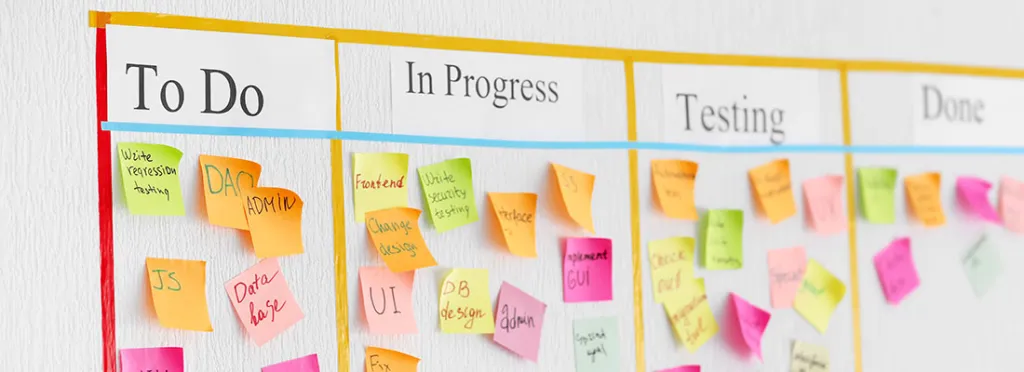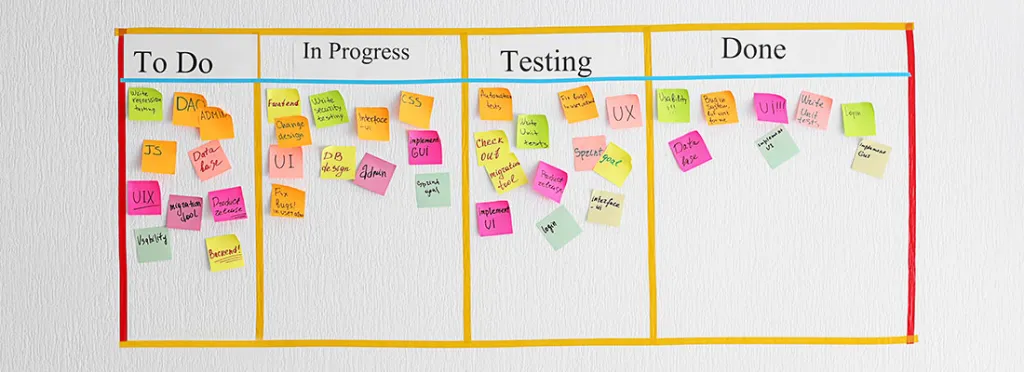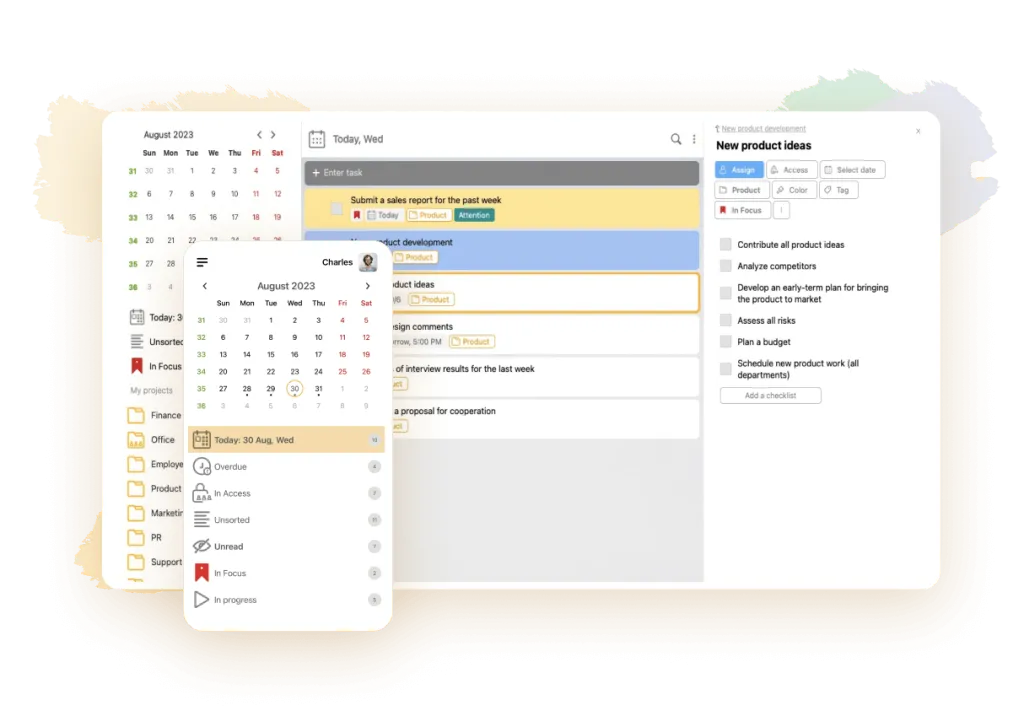
Max Miller
February 20, 2024
Every project consists of tasks that need to be managed. For this purpose, it is important to organise effective interaction between all team members. Each team member must clearly fulfil his responsibilities. To release a new product or launch a project, it is necessary to keep strict time limits and at the same time to perform tasks qualitatively. Many special technologies and tools have been developed for project management. One of them is Kanban methodology, developed in the 60s of the 20th century in Japan.
What it is
Literally translated, the word “kanban” means a signboard or billboard. This term, which denotes a system of task setting, where all stages of a project are displayed on special boards, was first used at one of the factories of the Japanese car brand Toyota. Its use in production allowed to visually monitor the quality of each part at all stages.
The author of the method, engineer Taiichi Ono, based the system on the principle of supermarkets, where customers choose their own goods and put them in a trolley. In this case, this role was fulfilled by a warehouse with spare parts for car assembly. A card was attached to each container with parts. On it there was information about the name, article, quantity of parts. It indicated the department that sent the parts and their destination, the person responsible for assembly and shipment. Later, Toyota managers became interested in this theory.
At assembly, workers took the parts out of the containers with cards. New tags with the nomenclature and quantity of parts were attached to the empty boxes. They were transported back to the warehouse. From the information on the cards, the employees knew exactly where a part was located. This greatly simplified and accelerated the assembly process, reduced the scrap rate and had a positive effect on the quality of the assembly.
The history of Kanban methodology began in the early 2000s when it started to be actively used in software development. Nowadays, it is a part of agile-philosophy and works based on the principles of “Agile Software Development Manifesto”. The main goal of the method: timely delivery of a high-quality and capable product. Let’s learn more about the spheres in which the technology is used besides project management and software development and how it works in practice.
Where Kanban methodology is used
The Japanese kanban system as a methodology is suitable for all projects in which it is possible to distinguish stages and separate types of tasks. With its help, you can plan tasks within a project, distribute them among employees, and control deadlines for their fulfilment. The methodology allows you to make all work processes visual, track the level of workload of specialists and the readiness of tasks at each stage.
Examples of implementation in a variety of business areas including:
-
Manufacturing of industrial goods. Using the Kanban method, it is possible to avoid problems associated with shortage or oversupply of spare parts and raw materials when manufacturing a new product. By clearly seeing the consumption of materials, the employees of the assembly area will order the necessary components, focusing on the volume of manufactured products. In this way, all workshops and areas will be loaded evenly.
-
Managing Teams in IT. In this case, the end product will be software. Kanban methodology will ensure smooth work of all team members. The process of developing a site using this technology will look like this: To create a site attracts a designer who creates a layout. After the layout is approved, it goes to the programmer, who prescribes its technical part. Next, the task goes to the tester who identifies errors. The product is finalised and demonstrated to the customer. Each subsequent participant in the process performs its own tasks based on the volume of tasks performed by its predecessor.
-
Sales. The idea of kanban boards has found application in the field of customer collaboration. It is used when building sales funnels. With its help it is easier to establish communication between the performers and the customer.
-
Personal Planning. Personal Kanban board successfully replaces the usual diary. On it you can record your personal tasks by day, week or month and keep track of their regular fulfilment.
Tasks can be recorded on a chalkboard, magnetic board or as notes in special digital applications on a computer, smartphone or tablet. For clarity, boards are divided into columns containing information on the status of all current project activities. The description, priority of each task is contained in its kanban card. As each stage is completed, the card is moved to the appropriate column: “In Progress”, “Done”, “Finalised”, etc.
Principles and rules of system construction

The Kanban method is based on the following basic principles:
-
Visualisations. It is based on a chalk, paper or virtual board divided into columns corresponding to the stages of the project.
-
A clear distribution of tasks between performers. This improves mutual understanding and co-operation in the team.
-
Full concentration.
To achieve a positive result with this method, it is important to observe the following conditions:
-
To begin with, you need to organise your work with the data and materials you have at your disposal at the moment. You should not wait for any changes. As you continue to work on the project, you will have the opportunity to improve it with new technologies.
-
All changes made to the project should be evolutionary in nature. Revolution is not justified in this case. Any global restructuring will introduce dissonance into the workflow, and you risk a complete failure of the project. Any adjustments should be measured and incremental.
-
Order, first and foremost. Everyone involved in the process should do their job. The designer should not take on testing the product, and the programmer should not spend time “drawing the site’s header”. All assigned roles and responsibilities must be clearly fulfilled. These two rules have the greatest impact on the quality of the project.
-
The initiative of employees should be encouraged. All suggestions to improve the project should be considered and taken into account. Many results are much easier to achieve when collective thinking is involved.
Advantages and disadvantages
A mandatory element of Kanban development is the whiteboard. It is present in all aspects of the agile methodology, including Scrum. It is freely accessible to all participants in the work process. Everyone can see what stage of work the task is at.
The kanban board can be roughly compared to the movement of a bus. Its end point is the final project. The stops it makes along the way are checkpoints or intermediate stages. The bus itself is visualised in the form of cards mounted on a board. Each “passenger”, aka team member, knows what goal should be achieved in the end, at what time it is necessary to join the process to solve the main task. As a result, everyone’s work becomes clear and transparent.
Among the advantages of the methodology are worth highlighting:
-
Flexible planning with the ability to make adjustments as the project progresses.
-
Increased staff commitment through working together on projects.
-
Organisation of a balanced flow of goods in production warehouses, their correct loading.
-
Absolute transparency and visibility with no secrets for performers and clients.
Its downsides:
-
An inconvenience for teams of large size.
-
The Kanban method is not suitable for making strategic plans. Its goal is to solve problems in the here and now.
-
Threat of slowing down or disrupting a project by blocking one or more tasks.
Differences between Scrum, Kanban and Lean methodologies
Kanban method is often confused with another technology, Scrum, which is among the agile project management methods. But, there are significant differences between the two:
| Kanban method | Scrum |
|---|---|
| No meetings | Regular meetings are held. |
| A team of highly specialised specialists is selected | The roles of performers can change and they interact with each other |
| There is no direct management of the project | A leader is appointed, responsible for the project, organising meetings, controlling the stages of tasks. |
| The planning is handled by a team | Project plans are made by the designated leader |
Agile agile methods also include kaizen and Lean Management, which has been called “lean production methodologies”. Just like Kanban method, it implies evolutionary introduction of any changes within the project implementation. Its goal is to eliminate all possible interferences that may, for whatever reason, interfere with production.
Today, when talking about kanban methodology, one cannot help but think about the features of the Waterfall method. This waterfall algorithm is characterised by the clarity of timing and processes in the cascade model. In comparison with kanban methodology there are pros and cons of waterfall. Usually, the difference between these well-known approaches lies in their definitions and values. But visual optimisation is a common element for them.
Problems when using Kanban

Despite being transparent and easy to understand, some teams make mistakes when implementing Kanban technology into their workflows. Because of this, the tool doesn’t work properly, failing to live up to expectations. This often happens for the following reasons:
-
Employees do not understand what the essence of the methodology is, why the cards are needed and how their completion affects the speed of work on the project.
-
The deadlines set for each task are not met. Because of this, rework occurs. The number of cards is increasing and the meaning of many of them is lost.
-
Task statuses are not changed in a timely manner. After the stage is completed, the card is still in its place. This prevents tracking the real workload of the participants and misleads other team members.
-
Tasks are not grouped by priority. For this reason, really important and serious tasks can be pushed to the “background” and lost among secondary tasks.
-
There is a lack of full-fledged communication with the team. This hinders the improvement of work and worsens mutual understanding between the participants of the work process. Everyone should be able to make their own suggestions on the project. And they should definitely be heard by the other participants.
How it works in practice
As mentioned earlier, Kanban boards can be physical or digital. In the first case, a conventional magnetic or chalk board is divided into several columns. Texts and task descriptions are placed on post-its, which are fixed in the corresponding columns, moving from there as each stage of the task is completed. Electronic kanban boards function on the same principle. But, unlike physical boards, all employees have access to them. This is especially convenient when working with teams of remote employees. These include the most popular foreign services:
-
Trello. Ideal tool in kanban work. It supports any number of projects. The program provides colour coding of tasks, attachments, comments. Integrates with other digital applications. It has a free and paid version.
-
Taskify. A very clear tool with three columns: “List”, “In Progress” and “Done”.
-
Asana. A full-fledged CRM system for project and team management with support for Kanban board function.
-
JIRA. Used to organise the work of teams in the IT sphere. Suitable for large industrial companies with an increased staff of specialists. Designed for creating, maintaining projects and tracking programme errors. Integrates with many digital services.
Kanban boards in the LeaderTask app

The modern digital service LeaderTask offers a variety of functions for effective collaboration on projects. Among its main functions is an electronic Kanban board designed to visualise project work.
In the app, you can:
-
Create projects, tasks, and cards.
-
Move them between stages as each task is completed.
-
Monitor the workload of each team member.
-
Allocate assignments to responsible executors.
-
Prioritise tasks.
-
Organise interaction between clients and performers.
With the Kanban board in LeaderTask, you can always see the full picture of what is happening on the project. This will help to discipline the team, making the work more organised and of higher quality. It differs from other top services in that it works offline, without internet. Synchronises with other popular applications. Suitable for all digital platforms.
Conclusion
In life, when starting to use the Japanese Kanban methodology, it is important to maintain discipline. This method can be implemented in any project. Using the tools of the method, it is much easier to achieve the realisation of professional and personal tasks. With its help it is convenient to track progress in the work on projects, control the consumption of resources, make timely adjustments if necessary.
Seeing all work processes on the board, each employee will have an idea of the importance and priority of his task. The further movement of the project will depend on how correctly he fulfils it.








